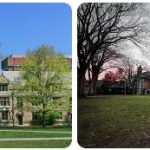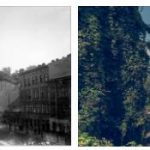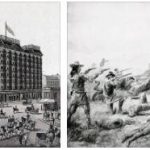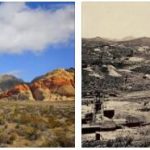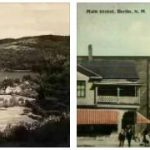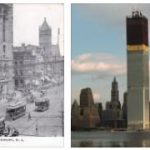Population: 9 876.187 thousand people (2011)
Area: 250493.0 sq. km
Each of the US states has its own nickname among the people. Michigan has four such nicknames: the Great Lakes State, the Car State, the Wolverine State, and the Water-Winter Wonderland State. Four of the five Great Lakes surround the state: Superior, Huron, Michigan, Erie. Mishigami means “big water” in the Ojibwa language. 40% of the state is covered by water.
The outlines of the shores of the Great Lakes system form two large peninsulas (Upper and Lower), on which most of the state’s land is located. There are many islands of various sizes in the Great Lakes. It is dominated by wooded hills cut by small rivers. Michigan has plenty of shallow lakes, while the Upper Peninsula is swampy. Weather conditions correspond to a temperate continental climate. The bowels of Michigan contain oil, iron, natural gas. Peat is also mined here (1st place in the USA). Plant diversity is great, especially among forest species.
The most numerous tribes that inhabited the territory of Michigan were Chippewa (Ojibwa), Huron, Potawatomi and Ottawa. Europeans arrived in this region only in the 17th century. Sault Ste. Marie is the first settlement (1668) in the state. Antoine Cadillac, an explorer and officer of the French army, founded Fort Detroit in 1701. In the middle of the 18th century, the colonial policy of France encountered the resistance of the Indians, as a result of which the lands of Michigan passed to Great Britain.(1763). Within its present borders, the state of Michigan was formed as a “territory” in 1805. In 1812-15, Michigan was controlled by the British for some time (during the Anglo-American War). In the 1830s, when the population of the territory increased significantly due to the massive development of the Wild West, the 26th US state, Michigan, was formed.
Cultural attractions are concentrated predominantly in Detroit. There are a large number of museums: African American History, Arts, Historical, Science Center, Great Lakes, Motown (Automotive History of Detroit ) and others. The state has developed active tourism. Michigan is traditionally considered a fishing and hunting region. Also kayakers, hikers, nature lovers aspire here.
GRAND RAPIDS
Population: 188,040 thousand people (2010)
Area: 117.4 sq. km
Founded: 1826
City status since: 1850
Time zone: UTC-5, summer UTC-4
Altitude: 195 m
The city of Grand Rapids is located in the western part of the state and is second only to Detroit in terms of the number of people living in it.. Warm summers with heavy rains and snowy winters are separated by a short off-season. The city is known as the birthplace of five well-known giants in the production of high-quality furniture. Once small firms that first appeared here, over time, they have grown into large manufacturers with a worldwide reputation. Obviously, these circumstances were the root cause of its unofficial name “City of Furniture”. But not only interior items are the property of local manufacturers. Firms specializing in information technology and the production of consumer goods thrive here. Health care institutions, aviation and automotive industries bring significant income to the city.
The area on which the city now stands was inhabited more than 2000 years ago. It was inhabited by peoples related to the culture of Hopewell. Later, the Ottawa Indian tribe came here and settled here for a long time, building their villages. At the beginning of the 19th century, during the period of development of the area by Europeans, missionaries arrived here to convert the Indians to Christianity. In addition to them, the territory was flooded with enterprising merchants who were engaged in profitable commerce. In exchange for bright textiles and cheap jewelry, they received magnificent furs and excellent leather from the Indians. Subsequently, Europeans of English origin founded a fur company here, which after a few decades moved to more favorable places for the development of commerce.
By the beginning of the second half of the 19th century, Grand Rapids was transformed into a center for furniture production. The fame of local masters quickly spread throughout America. After an international exhibition held in 1876 in Philadelphia, the city received the high title of world leader in the production of stylish and high-quality furniture. It filled the domestic markets for 75 years, and in the 1960s it entered the world level.
DETROIT
Population: 708.452 thousand people (2011)
Area: 370.2 sq. km
Detroit is a metropolis located in the state of Michigan, in the northern United States. Founded by French colonists in the early 18th century, Detroit was part of Canada until the early 19th century. The climate in the region is mild, humid continental, which softens the influence of the Great Lakes. Winters are mild, with a lot of snow, and summers are not hot, the average temperature does not rise above +24°C.
Detroit is known as a major automotive center, was the largest supplier of cars in the world. Its territory houses the production and research laboratories of such auto giants as Chrysler, General Motors and Ford. In addition, related to the automotive industry, the production of components, bearings, plastics and metal make a significant contribution to the city budget.
The main attraction of Detroit, visible from any part of the city, is an architectural ensemble consisting of seven skyscrapers owned by General Motors – Renaissance Center. From the observation deck, located on the 72nd floor of the main building, a magnificent panorama of the city and the river opens up, in addition, you can see the Canadian city of Windsor from there, located on the other side of the border. And in the heart of the city is the Tiger Park, which got its name due to the sculptures and bas-reliefs of tigers located throughout its territory. All park carousels and attractions have an image of this totem.
No less interesting for tourists coming to Detroit is the Henry Ford Museum, whose exposition includes very curious exhibits, such as Kennedy’s car, Lincoln ‘s chair, or things related to assassination attempts on presidents and other top officials of the state.
Now one of the richest cities in North America is experiencing a period of decline, which led to the global economic crisis and the decline in the automotive industry, which formed the basis of the city. This led to a reduction in jobs and, as a result, the outflow of the solvent population to other regions of the country. In this regard, there was a jump in the growth of crime, and today Detroit is considered one of the most criminogenic cities in the United States. A depressing impression is made by the view of completely abandoned quarters, and the picture of the streets is not surprising, on one side they are quite prosperous, with open shops and bright advertising of shop windows, and on the other – abandoned skyscrapers, with trees sprouting through the facades. Repeated attempts to breathe life into the city again have not led to anything.
Ann Arbor, Michigan
Ann Arbor, Michigan, is a city with a rich history shaped by its origins as a frontier outpost, the establishment of the University of Michigan, and its role as a center for education, culture, and innovation. The city’s climate, influenced by its location in the Great Lakes region, contributes to its distinctive seasons and outdoor activities enjoyed by residents and visitors.
Ann Arbor’s history traces back to the early 19th century when it was founded in 1824 as a site for the University of Michigan. Originally named “Annarbour,” the city’s early growth was influenced by its role as a center for education and the location of the state’s flagship university. The university’s establishment marked a crucial chapter in Ann Arbor’s development, laying the foundation for its identity as a knowledge hub.
The University of Michigan, founded in 1817 in Detroit before moving to Ann Arbor, has played a central role in the city’s growth and cultural vibrancy. The university has been a source of innovation, research, and academic excellence, attracting students and faculty from around the world. Today, it stands as one of the leading public research universities in the United States.
According to Rctoysadvice, the city’s climate is characterized by four distinct seasons, typical of the Midwest. Summers in Ann Arbor are warm, with average high temperatures ranging from the mid-70s to mid-80s Fahrenheit (24-29°C). Winters are cold, with average high temperatures in the 30s and 40s Fahrenheit (-1 to 7°C). Ann Arbor experiences moderate precipitation throughout the year, with occasional snowfall in the winter months.
The changing seasons contribute to a variety of outdoor activities enjoyed by Ann Arbor residents. The city is home to numerous parks and green spaces, including the expansive Nichols Arboretum and Gallup Park along the Huron River. These areas provide opportunities for hiking, picnicking, and enjoying nature, enhancing the quality of life for residents.
Ann Arbor’s commitment to education extends beyond the university to its public school system, which is highly regarded for its quality. The city’s emphasis on intellectual and cultural pursuits is evident in its numerous libraries, museums, and cultural institutions. The Ann Arbor District Library, for example, serves as a community hub for learning and engagement.
Cultural events and festivals contribute to the city’s vibrant atmosphere. The Ann Arbor Art Fair, one of the largest juried art fairs in the country, attracts artists and visitors alike, transforming the downtown area into a lively art showcase. The city’s diverse culinary scene, influenced by its multicultural population, offers a range of dining options, from local favorites to international cuisine.
Historic preservation efforts in Ann Arbor are reflected in the Kerrytown District, known for its historic market and charming streets. Old West Side, another historic neighborhood, features well-preserved homes from the 19th and early 20th centuries, showcasing the city’s architectural heritage.
In recent decades, Ann Arbor has become a hub for technology, research, and innovation. The city’s Research Park and technology incubators contribute to its reputation as a center for entrepreneurship and cutting-edge industries. The presence of automotive research centers and tech companies underscores Ann Arbor’s role in advancing various fields.
Transportation initiatives, including a robust public transit system and a focus on walkability and bike-friendly infrastructure, contribute to the city’s sustainability efforts. Ann Arbor’s commitment to environmental stewardship aligns with its residents’ values and enhances the overall quality of life.
Ann Arbor, Michigan, stands as a city with a dynamic history, marked by its educational legacy, cultural richness, and commitment to innovation. From its beginnings as a frontier outpost to its current status as a thriving knowledge hub, Ann Arbor reflects the resilience and adaptability of cities in the Midwest. The city’s climate, with its distinct seasons, adds to the diverse range of experiences enjoyed by its residents and makes Ann Arbor an inviting and dynamic place to live and visit.


